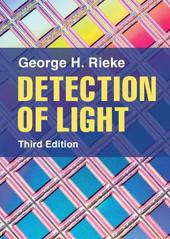
|
Detection of Light
Hardback
Main Details
| Title |
Detection of Light
|
| Authors and Contributors |
By (author) George H. Rieke
|
| Physical Properties |
| Format:Hardback | | Pages:450 | | Dimensions(mm): Height 175,Width 250 |
|
| Category/Genre | Observatories, equipment and methods
Optics |
|---|
| ISBN/Barcode |
9781107124141
|
| Classifications | Dewey:621.362 |
|---|
| Audience | | Professional & Vocational | |
|---|
| Edition |
3rd Revised edition
|
|
Publishing Details |
| Publisher |
Cambridge University Press
|
| Imprint |
Cambridge University Press
|
| Publication Date |
13 May 2021 |
| Publication Country |
United Kingdom
|
Description
The invention and development of advanced methods to detect light underlies much of modern technology. This fully updated and restructured third edition is unique amongst the literature, providing a comprehensive, uniform discussion of a broad range of detection approaches. The material is accessible to a broad range of readers rather than just highly trained specialists, beginning with first principles and developing the relevant physics as it goes. The book emphasizes physical understanding of detector operation, without being a catalog of current examples. It is self-contained but also provides a bridge to more specialized works on specific approaches; each chapter points readers toward the relevant literature. This will provide a broad and lasting understanding of the methods for detecting light that underpin so much of our technology. The book is suitable for advanced undergraduate and graduate students, and will provide a valuable reference for professionals across physics and engineering disciplines.
Author Biography
George H. Rieke is Regents Professor of Astronomy and Planetary Sciences at the University of Arizona. He switched from TeV gamma rays to the infrared just in time to enjoy its growth from primitive beginnings, to culminate with the launch of JWST. He has contributed to many scientific and technical topics along the way, gaining the background for this broad-ranging book. His other books include The Last of the Great Observatories (2006) and Measuring the Universe (Cambridge, 2017), which won the American Astronomical Society's Chambliss Astronomical Writing Award.
Reviews'The book introduces the detection of light and is designed to be accessible to a broad range of readers rather than just highly trained specialists ... is an ideal read for master's and Ph.D. students in astronomical instrumentation.' Silvano Donati, Optics & Photonics News 'The book is increased in breadth from earlier editions, and now covers the vast majority of the electromagnetic spectrum, from millimetre wavelengths to X-rays ... it is undoubtedly authoritative, as expected from a leading practising expert in the field ... underlying physics is explained at just the right depth required to understand each type of detector ... it gets beyond simplistic, generic descriptions to explain how and why real-world detectors have been refined in design, clarifying the strengths and weaknesses of each modification or increased layer of sophistication ... the book could be usefully purchased as 'technical backup' by those involved in teaching, say, observational astronomy. It is also pitched at just the right level for masterslevel or postgraduate students pursuing work involving the development of astronomical instrumentation, or indeed any area of physics involving photon detection.' James S. Dunlop, The Observatory
|